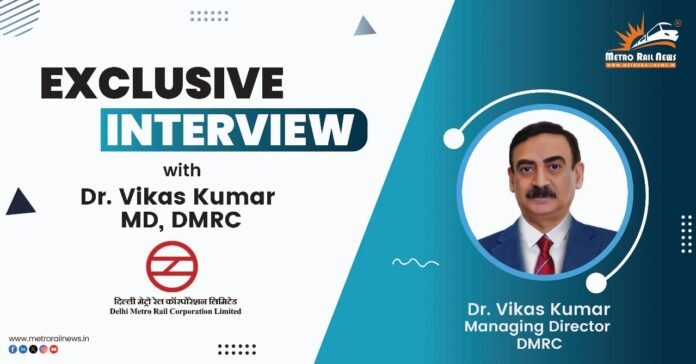Metro Rail News conducted an exclusive interview with Dr. Vikas Kumar, MD of Delhi Metro Rail Corporation (DMRC). The interview focused on the Delhi Metro Phase IV project. Shri Kumar discussed the project’s potential to enhance connectivity and mentioned advanced technologies like UTO and CBTC incorporated into Delhi Metro operations. During the interview, Shri Kumar highlighted DMRC’s commitment to sustainability through renewable energy, green practices, and efforts to minimize passenger disruptions. He also emphasised DMRC’s consultancy role in metro projects across India and abroad.
The upcoming Phase IV promises to transform Delhi’s connectivity. How will it improve travel times and accessibility across the city? Can you quantify the expected ridership increase upon completion?
Phase IV of Delhi Metro will significantly enhance connectivity and reduce travel times across the city. Key milestones, including tunnelling breakthroughs and viaduct construction, have been achieved and the Janakpuri West-Krishna Park Extension stretch is now ready for operations. Work is in progress on the other stretches as well. We have recently received the first set of train for the ensuing phase as well.
The primary idea behind the new phase-4 corridors is to interconnect the already operational corridors and provide passengers with more alternatives.
While Phase IV is ambitious, what are the potential roadblocks DMRC anticipates, and how will you ensure timely and cost-effective completion?
The pandemic was a major challenge for the project and now land acquisition and tree cutting permission are a few challenges which are yet to be resolved completely. Our approach focuses on proactive engagement with all stakeholders, meticulous planning, and deployment of advanced project management techniques to minimize risks. This way we can ensure timely and cost-effective project completion through strategic resource allocation and continuous monitoring of projects.
With the foundation stones laid, what is the projected timeline for Phase IV completion? How is DMRC managing the budget to avoid cost overruns?
The Phase 4 project is progressing steadily as a portion of the Janakpuri West- RK Ashram Marg corridor connecting Janakpuri West and Krishna Park Extension Metro station is now ready for operations. The Maujpur to Majlis Park Corridor will open next year in a phased manner, while the remaining structures of Janakpuri West- RK Ashram Marg and Delhi Aerocity- Tughlakabad will open in phases by the end of 2026. Additionally, two new corridors, viz; Inderlok- Indraprastha and Lajpat Nagar- Saket G Block are in pre-tendering stage.
We stick to the budget by inviting competitive bids, keeping a close watch on expenses, and finding smart ways to use resources effectively without lowering the quality.
What cutting-edge technologies are being incorporated into upcoming phases to enhance safety, operational efficiency, and the passenger experience? Can you share specific examples?
Delhi Metro employs cutting-edge technologies to ensure safety, operational efficiency, and enhanced passenger experience. It includes:
- Unattended Train Operation (UTO): Trains on the Magenta and Pink Lines are equipped with the UTO technology enabling efficient, punctual and safe operations.
- Fail-Safe and CBTC Systems: Trains are equipped with fail-safe technology, automatically halting in case of technical issues. Communication-Based Train Control (CBTC) ensures safe and efficient operations, even during high-frequency periods.
- Platform Screen Doors (PSDs): These prevent contact between passengers and tracks, enhancing safety at stations.
- Internet of Things (IoT) and Big Data Integration: Internet of Things (IoT)-based predictive maintenance and the indigenously developed i-ATS (Indigenous-Automatic Train Supervision) system improves operational efficiency and reliability, aligning with the ‘Make in India’ initiative.
- Digital Solutions: QR-based ticketing, National Common Mobility Cards (NCMC), contactless payments, and the DMRC mobile app enhance travel convenience.
- Real-Time Project Monitoring: The STAMP (System for Tracking and Monitoring Project) system tracks project progress, ensuring timely delivery and effective resource management.
- AI-powered virtual assistant: DMRC recently launched Beta version of an AI-powered virtual assistant, “Chetna” on its official website. This chatbot offers the commuters immediate responses to queries related to Metro travel, such as travel routes, fare calculations, and station details.
How is DMRC integrating sustainability and environmental considerations into its expansion plans? Are there initiatives for using renewable energy or reducing the carbon footprint?
DMRC prioritizes sustainability in its operations and expansion. As a non-polluting system, it was the first rail-based entity globally to earn carbon credits for regenerative braking and modal shift initiatives. Regenerative braking saves up to 30% energy, while the modal shift reduces vehicular emissions. DMRC constructs green-certified buildings; plant 10 trees for every tree removed, and meets 35% of its energy needs through renewables, including 50 MWp from rooftop solar and 100 MWp from the Rewa Solar Project. Phase-IV focuses on solar energy, green buildings, rainwater harvesting, and energy-efficient practices.
With ongoing projects, how does DMRC plan to maintain customer satisfaction and minimize disruptions during construction? Are there specific communication plans to keep passengers informed?
DMRC is committed to minimizing commuter disruptions during Phase IV works through planned construction schedules and alternative traffic management. Regular updates through media, social platforms, and transmission of updated information through our website to ensure commuters that remain informed about changes. We maintain a customer-first approach to quickly address grievances and ensure passenger convenience during this transitional period through social media and website. Community Interaction programmes are organized in various areas near the sites to keep the residents informed about the construction plans and seeks their feedback.
Can you discuss the funding strategy for the Phase IV project? What is the role of government support in this regard?
DMRC projects are primarily funded through loans from Japan International Cooperation Agency (JICA) along with a blend of government contributions and DMRC’s internal accruals. Government support remains integral for this extensive project, enabling infrastructure investment while facilitating accessibility and social equity for citizens.
Are there any plans for further expansions beyond Phase IV? If so, can you please share the details about potential new corridors or services?
DMRC continues to evaluate expansion opportunities post-Phase IV to meet Delhi-NCR’s evolving needs. Preliminary studies are underway to identify new corridors and improve connectivity to surrounding regions. Potential areas of focus include enhancing connectivity to the periphery and extending the metro network to boost public transport accessibility.
What initiatives has DMRC undertaken recently to streamline passenger experience?
Delhi Metro Rail Corporation (DMRC) prioritizes passenger experience by utilizing digital platforms and mobile apps to provide real-time information/updates in order to enhance convenience. The DMRC mobile apps, like Momentum 2.0 Delhi Sarthi-सारथी app, offer features such as route planning, ticket integration, fare calculation, station information, and real-time train updates. Contactless ticketing is available via WhatsApp QR code ticketing, UPI payments at Ticket Vending Machines (TVMs) and Paper QR Tickets.
DMRC has an effective social media presence on X (formerly called Twitter), Facebook, Instagram, and LinkedIn, with impressive follower counts and high engagement rates. These platforms are primarily used to address queries, provide timely operational updates; ensuring commuters are well-informed about any delays.
Would you please highlight DMRC’s role in the ongoing metro projects in India and abroad, such as the Patna Metro and Bhubaneswar Metro?
DMRC is providing consultancy for metro projects in cities like Patna, Bhubaneswar, Mumbai, etc. We are sharing our expertise beyond India as well, with the implementation & commissioning of metro systems in Dhaka. Overall, our role encompasses providing consultancy, sharing best practices in engineering and operations, and transferring valuable learnings.
What message do you have for the readers of Metro Rail News and the commuters of Delhi Metro?
I extend my heartfelt appreciation to all Delhi Metro commuters and readers for their continued trust and support. DMRC remains committed to delivering a world-class transit experience, prioritizing safety, efficiency, and sustainability. We are inspired by your patronage and remain dedicated to transforming urban mobility for a better future.







DMRC should not provide consultancy to Dhaka Metro. We all know what Bangladesh is doing with India.